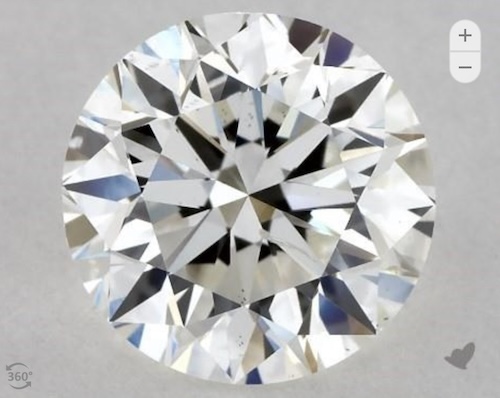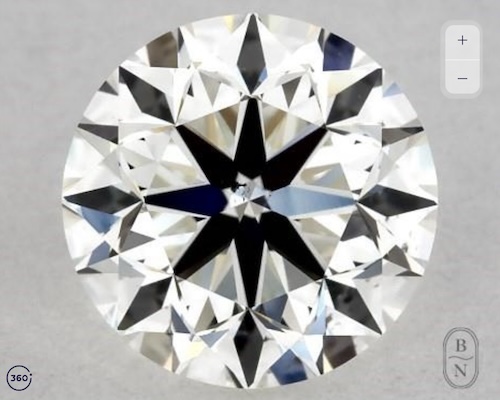Diamond Education
SI1 Clarity Diamonds
In the fascinating spectrum of diamond clarity, SI1 diamonds hold a special place, striking a balance between beauty and value. The term "SI1" stands for "Slightly Included 1," indicating that these diamonds contain inclusions that are often detectable under 10x magnification but are typically not visible to the naked eye. These inclusions can range from tiny internal crystals to minute feathers, but their presence is generally subtle.
SI1 diamonds offer a unique proposition to buyers. They provide the allure of a near-impeccable diamond without the premium price tag of higher clarity grades. For many, this clarity grade represents the sweet spot—offering a visually stunning diamond that, to the unaided eye, appears clean, yet comes at a more accessible price point.
As with all diamonds, the story they tell is not just of carbon subjected to immense heat and pressure but of nature's artistry and time's testament. SI1 diamonds, with their minor inclusions, remind us of the incredible journey each diamond undertakes, from deep within the Earth to the sparkle of a jewelry piece. They symbolize the beauty in imperfection and the value of authenticity.
How are SI1 Diamonds Graded?
Grading of SI1 diamonds follows a detailed and structured process, primarily conducted by recognized grading entities like the Gemological Institute of America (GIA). SI1, standing for "Slightly Included 1," is a grade on the diamond clarity chart. This grade indicates that the diamond contains inclusions that are quite easy to spot under 10x magnification by a skilled grader. The GIA's method for evaluating diamond clarity involves assessing the number, size, relief, nature, and position of these characteristics and determining how they affect the overall appearance of the stone.

GIA Clarity Scale
SI1 clarity diamonds are graded as being slightly included to the first degree. In most diamond shapes, the inclusions in SI1 clarity diamonds are almost always eye-clean, meaning the imperfections can't be seen with the naked eye. However, the size, color, and location of inclusions can vary, making some flaws noticeable without magnification. This variation necessitates a close review of each diamond, with particular attention to inclusions like clouds, feathers, and crystals. High-definition imagery is a crucial tool for determining if a diamond is eye-clean.
The clarity grade of a diamond is determined by the size and harshness of inclusions in relation to the size of the diamond. However, the grade alone does not indicate whether the inclusions will be noticeable to the naked eye. For instance, a 1/2 carat SI1 diamond might have small grey inclusions visible under magnification but may appear flawless when worn. Conversely, similar inclusions in a larger diamond, like a 3 carat SI1 diamond, could be more visible to the naked eye.
Obtaining a reliable certificate from a respected lab is crucial in assessing an SI1 diamond's quality. The GIA is renowned for its consistent grading, making their certificates highly trustworthy. In contrast, certificates from labs like the EGL might not be as reliable due to inconsistent grading, potentially leading to an SI1 diamond being of lower quality than indicated.
In summary, grading of SI1 diamonds involves a meticulous evaluation of inclusions using standard magnification tools, with the determination of eye-cleanliness being a key factor. The clarity grade provided by a reliable certificate, such as one from the GIA, is essential for accurately understanding the quality of an SI1 diamond.
Is SI1 Diamond Clarity a Good Choice?
SI1 diamonds, falling under the 'Slightly Included' category, emerge as a stellar choice for those navigating the complex world of diamond clarity. These diamonds, while containing inclusions visible under 10x magnification, strike an attractive balance between aesthetic appeal and affordability. They are particularly desirable for budget-conscious buyers, offering a more accessible price point than higher clarity grades.
The key to selecting a superb SI1 diamond is to focus on its 'eye-clean' status. An eye-clean SI1 diamond, with inclusions indiscernible to the naked eye, can look as impeccable as higher-graded diamonds. To ensure you're choosing the best SI1 diamond, it's crucial to use high-resolution images and videos provided by vendors. These tools allow for a closer examination of the diamond, ensuring that any inclusions are strategically placed or too minute to affect its overall beauty. By carefully evaluating these aspects, you can find an SI1 diamond that combines quality and value, making it an excellent choice for those seeking beauty without overspending.
Is an SI1 Diamond Eye-Clean?
The term "eye-clean" refers to diamonds where inclusions are not visible to the naked eye. While many SI1 diamonds are eye-clean, this clarity grade does not automatically guarantee such a characteristic. Given the variability in inclusions' size, number, and location, some SI1 diamonds might have more noticeable imperfections.

This image highlights an important feature on Whiteflash's diamond information page: the 'eye clean' tag. Displayed prominently, this tag indicates that the diamond has been assessed and found to have no visible inclusions to the naked eye, conforming to the rigorous standards of eye-cleanliness. This visual marker serves as a quick and reliable guide for customers, helping them identify diamonds that offer clarity and beauty without the need for detailed examination, making their selection process easier and more informed.
Buyers must do their due diligence when considering an SI1 diamond. Always consult with the vendor regarding the diamond's eye-clean status. Many reputable vendors often provide this information on the diamond's product page. Additionally, the significance of diamond images and HD videos is paramount. These visual tools offer a clear insight into the diamond's appearance, enabling buyers to assess the visibility and position of inclusions. By meticulously examining these resources, one can make a well-informed decision, ensuring the diamond meets their visual expectations.
Which is Better: VS2 or SI1?
When comparing diamond clarity grades, the choice between VS2 and SI1 often emerges as a common dilemma for buyers. Both these grades fall within the range where inclusions are typically minor and can offer good value, but there are distinct differences to consider.
VS2 stands for "Very Slightly Included 2," indicating that the diamond has minor inclusions that are difficult to see under 10x magnification and are typically not visible to the naked eye. These inclusions are often smaller, fewer in number, or better positioned within the diamond, ensuring minimal impact on its overall appearance.
SI1, as previously discussed, stands for "Slightly Included 1." While many SI1 diamonds are eye-clean, there's a higher likelihood of visible inclusions compared to VS2 diamonds. The inclusions in SI1 diamonds might be larger, more numerous, or located in more conspicuous areas.
In terms of pure clarity grading, VS2 is a higher grade than SI1. Therefore, VS2 diamonds often command a higher price. However, the real question is about value and individual preferences. If you can find an eye-clean SI1 diamond that meets your other criteria (like cut, color, and carat), it can offer better value for money than a VS2 diamond. On the other hand, if utmost clarity with minimal risk of visible inclusions is a priority, then a VS2 diamond might be the better choice.
The world of diamonds is vast and intricate, with each clarity grade telling its own unique story. Whether you're considering the pristine allure of Flawless diamonds, the balanced beauty of SI1, or the refined clarity of VS2, the key is to make an informed decision that aligns with your personal preferences, values, and budget. Remember, a diamond is not just a gem; it's a symbol of moments, memories, and emotions. By understanding the nuances of clarity grades and making a well-informed choice, you ensure that your diamond resonates with the significance you attach to it.



